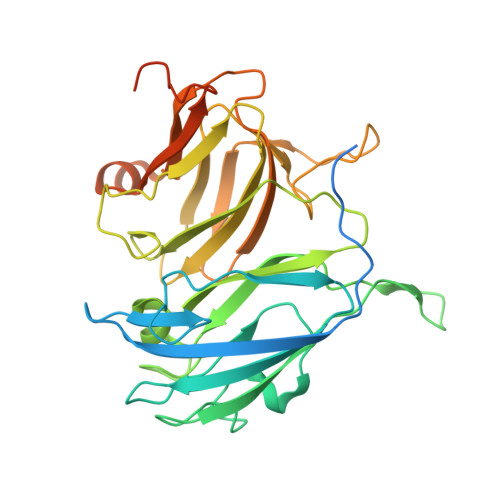Substitution of the Methionine Axial Ligand of the T1 Copper for the Fungal-like Phenylalanine Ligand (M298F) Causes Local Structural Perturbations that Lead to Thermal Instability and Reduced Catalytic Efficiency of the Small Laccase from Streptomyces coelicolor A3(2).
Zovo, K., Pupart, H., Van Wieren, A., Gillilan, R.E., Huang, Q., Majumdar, S., Lukk, T.(2022) ACS Omega 7: 6184-6194
- PubMed: 35224382
- DOI: https://doi.org/10.1021/acsomega.1c06668
- Primary Citation of Related Structures:
7B2K, 7B4Y, 7BDN, 7BFM - PubMed Abstract:
Many industrial processes operate at elevated temperatures or within broad pH and salinity ranges. However, the utilization of enzymes to carry out biocatalysis in such processes is often impractical or even impossible. Laccases (EC 1.10.3.2), which constitute a large family of multicopper oxidases, have long been used in the industrial setting. Although fungal laccases are in many respects considered superior to their bacterial counterparts, the bacterial laccases have been receiving greater attention recently. Albeit lower in redox potential than fungal laccases, bacterial laccases are commonly thermally more stable, act within broader pH ranges, do not contain posttranslational modifications, and could therefore serve as a high potential scaffold for directed evolution for the production of enzymes with enhanced properties. Several examples focusing on the axial ligand mutations of the T1 copper site have been published in the past. However, structural evidence on the local and global changes induced by those mutations have thus far been of computational nature only. In this study, we set out to structurally and kinetically characterize a few of the most commonly reported axial ligand mutations of a bacterial small laccase (SLAC) from Streptomyces coelicolor . While one of the mutations (Met to Leu) equips the enzyme with better thermal stability, the other (Met to Phe) induces an opposite effect. These mutations cause local structural rearrangement of the T1 site as demonstrated by X-ray crystallography. Our analysis confirms past findings that for SLACs, single point mutations that change the identity of the axial ligand of the T1 copper are not enough to provide a substantial increase in the catalytic efficiency but can in some cases have a detrimental effect on the enzyme's thermal stability parameters instead.
Organizational Affiliation:
Department of Chemistry and Biotechnology, Tallinn University of Technology, Akadeemia tee 15, Tallinn 12618, Estonia.















